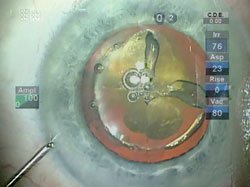Femtosecond laser cataract surgery can raise risk of capsular block
Preventive strategies include minimizing inflation of the anterior chamber, decompressing the lens capsule and regulating fluid volume, surgeon says.
Click Here to Manage Email Alerts
Gas generated during femtosecond laser-assisted refractive cataract surgery may produce posterior capsular tears and increase the risk of capsular block syndrome, according to a study.
The presence of intracapsular gas and laser-induced changes in the cortex are uniquely associated with femtosecond cataract surgery, Michael A. Lawless, MD, OSN APAO Edition Associate Editor, said at the Refractive Subspecialty Day preceding the American Academy of Ophthalmology meeting.
“The significant findings were that laser cataract surgery changes the intraoperative environment by the generation of intracapsular gas,” Dr. Lawless said in a subsequent email interview. “This, in conjunction with laser-induced changes in the cortex, can lead to capsular block syndrome with posterior capsular rupture. It is a preventable problem, but one that surgeons beginning laser cataract surgery should be aware of.”
Capsular block syndrome can result in posterior capsular rupture and posterior dislocation of the lens. It stems from a rapid increase in posterior fluid volume during hydrodissection that might occur if fluid flow from the capsular space is hindered.
“Because gas is liberated within the capsule, laser cataract surgery can contribute to capsular block syndrome. This is because with laser fragmentation of the lens, intralenticular gas is produced with a potential to increase intracapsular volume,” Dr. Lawless said.
Two complicated cases
 Image of the eye immediately prior to lens removal. Note the gas bubble posterior to the lens fragmentation pattern. Image: Lawless MA
|
Dr. Lawless reviewed two cases of capsular block syndrome that occurred in 50 femtosecond laser-assisted cataract procedures. A LenSx femtosecond laser (Alcon) was used to create capsulotomies, perform lens fragmentation and make corneal incisions.
Two patients developed posterior capsular tears after hydrodissection of the lens. This resulted in the lens shifting and migrating into the vitreous, Dr. Lawless said.
The patients underwent vitrectomy, lens extraction and implantation of sulcus-fixated posterior chamber IOLs. No complications were reported.
“In the two cases in our group, during hydrodissection, before we were aware of this potential complication, the posterior capsule ruptured and the lens dislocated into the posterior segment,” he said. “Luckily, within a few hours, a vitreoretinal surgeon had solved the problem by a vitreoretinal approach to remove the cataract, and a lens was placed in the sulcus without difficulty, and both patients achieved corrected 6/6 acuity.”
Preventive maneuvers
Capsular block syndrome is preventable with cautious observation, Dr. Lawless said.
“I think the introduction of this technology can be done very safely, but surgeons need to be aware that the intraoperative environment is better but different to what they are used to in normal phacoemulsification,” he said. “The steps we’ve described to bring this particular serious complication to the attention of surgeons are with the aim of preventing our experience being repeated for what is a potentially avoidable problem of laser cataract surgery.”
To prevent intracapsular gas syndrome, the surgeon should reduce the ophthalmic viscoelastic device fill before capsule removal to avoid over-inflation of the anterior chamber, he said. Then, the surgeon should decompress the anterior chamber before and during hydrodissection by exerting pressure on the posterior lip of the corneal incision with the elbow of the cannula. The surgeon should decompress the lens capsule during hydrodissection by raising the anterior capsule with the tip of the hydrodissection cannula during injection.
Hydrodissection fluid should be injected slowly, with fluid volume adjusted based on the expanding fluid wave. A pre-chopper or blunt-tipped side-port instrument should be used to slit the hemispheres before hydrodissection to let gas and/or injected fluid move forward, Dr. Lawless said.
He noted that he encountered no cases of capsular gas syndrome in more than 300 subsequent procedures. – by Matt Hasson
Reference:
Roberts TV, Sutton G, Lawless MA, Jindal-Bali S, Hodge C. Capsular block syndrome associated with femtosecond laser–assisted cataract surgery. J Cataract Refract Surg. 2011;37(11):2068-2070.
For more information:
Michael A. Lawless, MD, can be reached at Vision Eye Institute, Level 4, 270 Victoria Ave., Chatswood NSW 2067, Australia; 9424 9999; fax: +61-9415-4220; email: michael.lawless@vgaustralia.com.
Disclosure: Dr. Lawless is a member of the medical advisory board of Alcon/LenSx.
